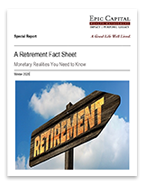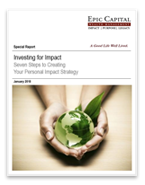2019 IRA Deadlines Are Approaching
Jan 13, 2020
Financially, many of us associate April with taxes – but we should also associate April with important IRA deadlines.
April 1, 2020 is the deadline to take your Required Minimum Distribution (RMD) from certain individual retirement accounts.
April 15, 2020 is the deadline for making annual contributions to a traditional IRA, Roth IRA, and certain other retirement accounts.1
Keep in mind that withdrawals from traditional, SIMPLE, and SEP-IRAs are taxed as ordinary income, and if taken before age 59½, may be subject to a 10% federal income tax penalty. Generally, once you reach age 70½, you must begin taking required minimum distributions.
To qualify for the tax-free and penalty-free withdrawal of earnings, Roth IRA distributions must meet a five-year holding requirement and occur after age 59½. Tax-free and penalty-free withdrawals can also be taken under certain other circumstances, such as a result of the owner’s death. The original Roth IRA owner is not required to take minimum annual withdrawals.
The earlier you make your annual IRA contribution, the better. You can make a yearly IRA contribution any time between January 1 of the current year and April 15 of the next year. So, the contribution window for 2019 started on January 1, 2019 and ends on April 15, 2020. Accordingly, you can make your IRA contribution for 2020 any time from January 1, 2020 to April 15, 2021.2
You may help manage your income tax bill if you are eligible to contribute to a traditional IRA.
To get the full tax deduction for your 2019 traditional IRA contribution, you have to meet one or more of these financial conditions:
*You aren’t eligible to participate in a workplace retirement plan.
*You are eligible to participate in a workplace retirement plan, but you are a single filer or head of household with Modified Adjusted Gross Income (MAGI) of $64,000 or less. (Or if you file jointly with your spouse, your combined MAGI is $103,000 or less.)3
*You aren’t eligible to participate in a workplace retirement plan, but your spouse is eligible and your combined 2019 gross income is $193,000 or less.4
If you are the original owner of a traditional IRA, you are no longer able to contribute to it starting in the year you turn 70½. If you are the original owner of a Roth IRA, you can contribute to it as long as you live, provided you have taxable compensation and MAGI below a certain level (see below).1,3
If you are making a 2019 IRA contribution in early 2020, be aware of this fact. You must tell the investment company hosting the IRA account which year the contribution is for. If you fail to indicate the tax year that the contribution applies to, the custodian firm may make a default assumption that the contribution is for the current year (and note exactly that to the I.R.S.).4
So, write “2020 IRA contribution” or “2019 IRA contribution,” as applicable, in the memo area of your check, plainly and simply. Be sure to write your account number on the check. Should you make your contribution electronically, double-check that these details are communicated.
How much can you put into an IRA this year? You can contribute up to $6,000 to a Roth or traditional IRA for the 2020 tax year; $7,000, if you will be 50 or older this year. (The same applies for the 2019 tax year). Should you make an IRA contribution exceeding these limits, you have until the following April 15 to correct the contribution with the help of an I.R.S. form. If you don’t, the amount of the excess contribution will be taxed at 6% each year the correction is avoided.1,4
The maximum contribution to a Roth IRA may be reduced because of Modified Adjusted Gross Income phaseouts, which kick in as follows.
2019 Tax Year4
Single/head of household: $122,000 – $137,000
Married filing jointly: $193,000 – $203,000
2020 Tax Year5
Single/head of household: $124,000 – $139,000
Married filing jointly: $196,000 – $206,000
The I.R.S. has other rules for other income brackets. If your MAGI falls within the applicable phase-out range, you may be eligible to make a partial contribution.3
A last-chance RMD deadline rolls around on April 1. If you turned 70½ in 2019, the I.R.S. has two ways for you to take your first RMD: you could a) take your first Required Minimum Distribution from your traditional IRA before December 31, 2019 or b) postpone it until as late as April 1, 2020.6
If you chose b), you will have to take two RMDs next year – one by April 1, 2020 and another by December 31, 2020. For subsequent years, your annual RMD deadline will be December 31. The investment firm that is the custodian of hosting your IRA should have already notified you of this consequence as well as the RMD amount(s) – in fact, they have probably calculated the RMD(s) for you.6
More Insights
You’re beginning to accumulate substantial wealth, but you worry about protecting it from future potential creditors. Whether your concern is for your personal assets or your business, various tools exist to keep your property safe from tax collectors, accident victims, health-care providers, credit card issuers, business creditors, and creditors of others. To insulate your property … Continue reading “Estate Planning – Protecting Your Assets”
You know how important it is to plan for your retirement, but where do you begin? One of your first steps should be to estimate how much income you’ll need to fund your retirement. That’s not as easy as it sounds, because retirement planning is not an exact science. Your specific needs depend on your … Continue reading “Estimating Your Retirement Income Needs”
As June begins, markets continue to navigate a complex landscape shaped by trade policy shifts, an uncertain economic and earnings outlook, and bond market headwinds. Several key developments in recent weeks may have implications for markets:
April showers came a month early as stocks fell in March. Tariffs were the primary cause of the market jitters, although that uncertainty became too much for markets to shrug off once economic data started to weaken.
A successful investor maximizes gain and minimizes loss. Though there can be no guarantee that any investment strategy will be successful and all investing involves risk, including the possible loss of principal, here are six basic principles that may help you invest more successfully.
Services
Epic Capital provides the following comprehensive financial planning and investment management services: Learn More >


 Top of Page
Top of Page











